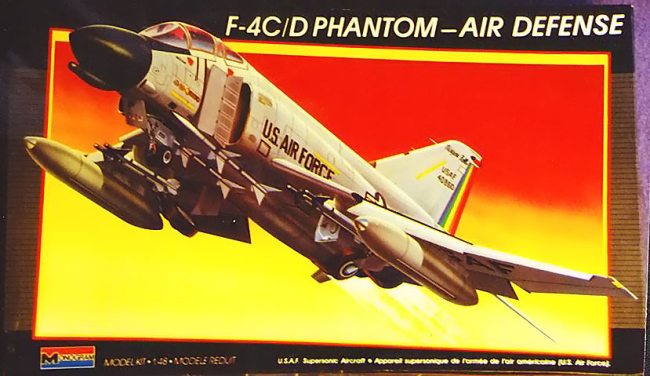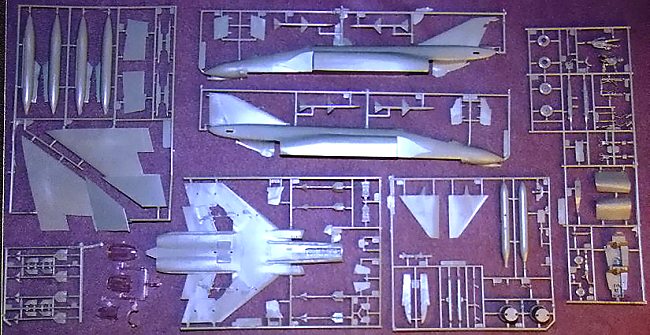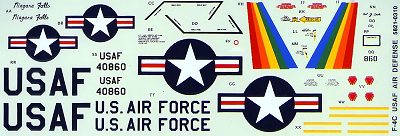
|
KIT: |
Monogram 1/48 F-4C/D Phantom II Preview |
|
KIT # |
5821 |
|
PRICE: |
$7.50 in 1986 |
|
DECALS: |
One aircraft, 136 FIS NY ANG |
|
REVIEW & |
Mark O. Williams |
|
NOTES: |
Currently (June 2001) OOP |

|
HISTORY |
The Phantom II was tasked as performing in the pure interceptor role about mid-career with the USAF in 1974, five years before Air Defense Command was absorbed into Tactical Air Command. The 57th FIS was the first and only active-duty, operational, ADC unit* to receive the F-4C, which they flew from 1975-1978, then flying the F-4E until deactivation. Although the first National Guard Fighter Interceptor Squadron to receive the Double Ugly was the 199th FIS of Hawaii in 1974, this unit became PACAF controlled soon after conversion. North Dakota (178th), Michigan (171st), Texas (111th), Oregon (144th), New York (136th), Minnesota (179th) and California (194th) all eventually flew the Air Defense version of the F-4. I know of two, active-duty Tactical Fighter Wings that did control F-4 squadrons with an air defense tasking however. They were the 36th TFS/51st TFW at Osan AB, Korea and the 525th TFS/86th TFW at Ramstein AB, Germany.
*Additionally, the Air Defense Weapons Center at Tyndall AFB, FL utilized the Phantom from 1977 to 1979 but transferred the re-equipment program to the ANG (Oregon) since the ANG was the primary Phantom air defense user.
It has been suggested that the F-4 was destined to replace the Century Series fighters (F-101, F-102, and F-106) in the air defense role since Project Highspeed in 1961, which pitted an F-4 against an F-106, and in which the F-4 arguably won. Phantom and Delta Dart lovers will continue to argue over the results of Project Highspeed for years to come (Iím for the Delta Dart which, by the way, flew air defense until 1988!) but suffice it to say the F-4 performed admirably in the air defense role.
|
THE KIT |

Just shy of 100 pieces the kit is a reboxing of the standard Monogram F-4 Phantom with additional options for a D (most notable the under-radome sensor) or unique C if so desired. (Most Air Defense units flew both at some time.) Copyright on the instruction sheet is 1987 and I have only been able to find this kit through on-line auctions. Several pieces have flashes of plastic around the mold and sprues but overall it is well made. The obligatory "” MMI" markings are located on the underside of the port horizontal stab. Both stabs each has three very noticeable ejector-pin marks on their undersides as well so they need some work. Panel lines are raised which I understand were pretty typical of the time. The cockpit was molded with raised instruments and seatbelts and includes control sticks for both seats as well as ejection seat handles. These handles need to be cleaned up a bit but are a nice touch. While not perfect, I was not anticipating this much detail so I look forward to working on painting it up. I need the practice! Wheel well detail is adequate in my opinion and Iíll feel satisfied with building it with wheels down. The wing flaps are molded with pins that, when attached to the wing, show them in a lowered position. Most of my photos show this to be accurate so all I can say is check references. Related to this are the underwing spoilers/speedbrakes which, can be depicted open or closed with fair detail, except for the actuator if opened. The actuator is molded into the wing. A seated and a standing pilot are included as well.
Several items are included with this kit including Ė but one inaccurately displayed in the instructions - a Chelton, LORAN "towel rack" antenna. As I have been told this antenna was used on maybe 30 or so F-4Ds and I have never seen a reference to an Air Defense unit utilizing this antenna and no F-4Cs used a LORAN system. Also included is an SUU-23 gun pod but donít be so quick to set that item aside. In fact, the gun was used on Air Defense Phantoms during an exercise called "Creek Claxon" in which 8 F-4Ds were tasked to perform Zulu Alert at Ramstein Air Base while the 86th TFW converted from the F-4E to the F-16C. The 178th, 179th and 194th FISs all contributed aircraft and crews for this duty from 1 March 1986 to 31 March 1987. (By the way, if Creek Claxon isnít a great military exercise name I donít know what is!!) Another nice touch is the inclusion of four, multi-part, nicely detailed AIM-9 Sidewinders that replace the rather plain looking Sidewinders molded onto the tree with the lower fuselage and wings. Four AIM-7 Sparrows are also included. Items that can be put in the spare parts box are the ECM pods and the camera pod. As far as I know these were not used by any Air Defense unit. If anyone knows differently about any of these items please let me know.
Noticeably missing from the kit is the VHF antenna used by some units for voice communications with civilian air traffic control. I have only seen this antenna Ė located aft of the in-flight refueling receptacle on the spine Ė on F-4Cs used by the 171st FIS but believe it was used on other aircraft. Forming some .020" scrap into an approximate 2mm by 4mm airfoil can make this antenna. As always, check your reference material.
 The kit provides decals for one aircraft (64-0860) of the 136th
FIS/107th FIG, New York Air National Guard, based out of Niagara
Falls. These are the original "rainbow" colors and in my opinion are
rather boring. The 136th FIS eventually exchanged these colors for an
equally boring design (again, in my opinion) when they dropped the ADC gray
paint scheme and went to the Hill Gray scheme. (No offense 136th
fans! I used to live in Niagara Falls!) Very basic paint information is provided
with the kit instructions so youíll have to use other references. The
beautiful, gloss, ADC gray (FS 16473) of course was the overall color most ANG
air defense units used Ė a hold over from the ADC days - although a few,
including the 57th FIS and the 178th FIS (North Dakota)
did utilize the standard SEA camouflage scheme for some time. Use standard, flat
black for the anti-glare shield, gloss black for the radome, and flat white in
the wheel wells. Simplicity! Numerous after-market decals are still readily
available from Experts-Choice for air defense Phantoms including the 179th
(Minnesota), 111th (Texas), and the 171st (Michigan)
Fighter Interceptor Squadrons. These E-C decals provide basic unit markings at
the most so youíll have to acquire detailed, F-4 stencils from another source.
The kit decals are stingy with the stencils as well.
The kit provides decals for one aircraft (64-0860) of the 136th
FIS/107th FIG, New York Air National Guard, based out of Niagara
Falls. These are the original "rainbow" colors and in my opinion are
rather boring. The 136th FIS eventually exchanged these colors for an
equally boring design (again, in my opinion) when they dropped the ADC gray
paint scheme and went to the Hill Gray scheme. (No offense 136th
fans! I used to live in Niagara Falls!) Very basic paint information is provided
with the kit instructions so youíll have to use other references. The
beautiful, gloss, ADC gray (FS 16473) of course was the overall color most ANG
air defense units used Ė a hold over from the ADC days - although a few,
including the 57th FIS and the 178th FIS (North Dakota)
did utilize the standard SEA camouflage scheme for some time. Use standard, flat
black for the anti-glare shield, gloss black for the radome, and flat white in
the wheel wells. Simplicity! Numerous after-market decals are still readily
available from Experts-Choice for air defense Phantoms including the 179th
(Minnesota), 111th (Texas), and the 171st (Michigan)
Fighter Interceptor Squadrons. These E-C decals provide basic unit markings at
the most so youíll have to acquire detailed, F-4 stencils from another source.
The kit decals are stingy with the stencils as well.

136 FIS F-4D in final 'boring' scheme, but with rhino on the nose.
Also note that several units, most notably Michiganís 171st FIS, used highly polished chrome for the tips of their wing tanks, luggage pods and Sidewinder missile racks in addition to the intake leading edges. Combined with the ADC gray paint job this made for a super looking Phantom and I plan on building my version with Michigan colors! (Experts-Choice decal sets 48-32 and 48-40 include options to build one of 19 different Michigan F-4C/Ds!)
|
CONCLUSIONS |
I guess you could call me a closet Phantom phan. Iíve always admired them but Iíve never researched this aircraft as much as Iíve wanted to (and it probably shows in this review!) However when I saw this kit I thought it would be a cool build and a nice addition to my Air Defense collection. It has been some time since Iíve built an F-4 of any version (read Ė "since I was a kid!") and although Iím aware there are newer and better F-4 kits available, I was pleasantly surprised when I opened up this box. Who knows, I may get hooked! Lotís of possibilities!
|
REFERENCES |
Foster, Peter R., USAF Fighter Interceptor Squadrons, Osprey Aerospace, London, 1994
If you would like your product reviewed fairly and quickly by a site that averages over 2,700 visits a day, please contact me or see other details in the Note to Contributors.